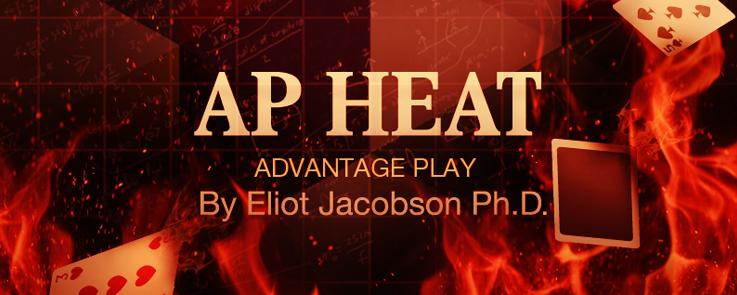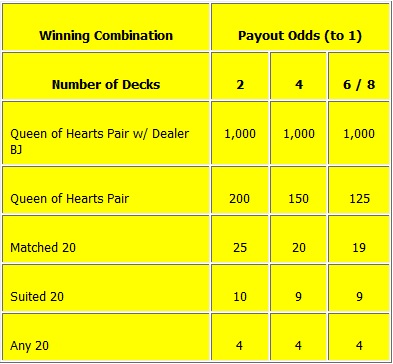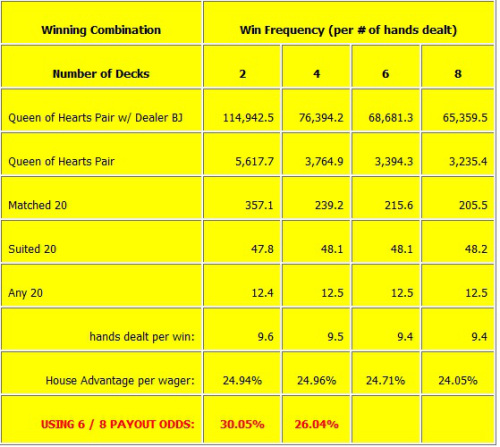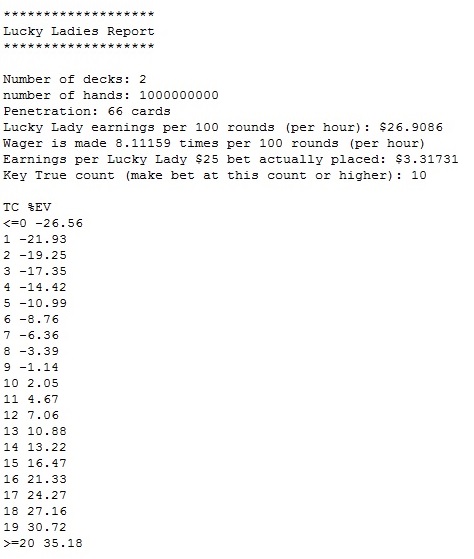Lucky Ladies: 10 Years Later

Just over 10 years ago I published an article in the Blackjack Insider newsletter on card counting the Lucky Ladies blackjack side bet (here is a link). That was my first one. I look back on that article and can see the love I had for conducting and publishing this type of analysis. Emphasis on publishing. Good APs at the time had any number of gripes against me, nearly all of which were true. I was arrogant, had a know-it-all attitude, was a lousy AP and went around spouting profitable information to the public for no apparent reason. Not much has changed.
I wrote this article from the player's point of view, using my moniker at the time "The Mayor."
Here it is in full, my August, 2003 article.
Playing the Lucky Ladies Side-Bet
(rev. 08/07/03)
by The Mayor
One of the lessons the advantage player quickly learns is that card-counting in blackjack is a tough way to make a buck. For years I heard rumors about the huge edge that some of my friends would get: front-loading, shuffle-tracking, ace-sequencing, card-steering, etc., etc. Occasionally I would find a game or a dealer where I could, for a few moments, get such an edge … but the leg work to find these games, together with their fickle nature, made it no sure bet they would be there tomorrow. And then Panama Rick posted about the Lucky Ladies on a popular blackjack website.
The Lucky Ladies (LL) side-bet pays out whenever the player's first two cards sum to 20. The payout schedule includes increased payoffs when the two cards are suited (e.g. Q of clubs, T of clubs), matched (e.g. Q of clubs, Q of clubs), or two Q of hearts. This side-bet was developed by Galaxy Gaming. Here are the payout schedules as listed on the Galaxy Gaming web site:

Here is the table of EV’s they list:

It is intuitively obvious that no matter what counting system you use, the higher the true count becomes, the more likely the player is to get a 20. So at some point this bet has positive EV and is worth playing. Unfortunately this bet is not worth much to the advantage player who wants to use his standard counting system to occasionally play this bet. According to Panama Rick, Hi-lo, for example, yields a return of about a $3 edge per hour (in a 6 deck game) and about $9 per hour against the LL in a 2D game.
A few months ago, I decided to design a counting system specifically to beat LL. Two things became obvious. First, I needed to play the LL double-deck game. Second, whatever system I developed – it would not look at all like a standard counting system, and therefore I would need a partner at the table with me. My partner would signal the count in case I wanted to vary my play or raise my bet, and I would signal when to make the LL bet.
To solve the first problem, I called Galaxy Gaming. This was a very interesting phone call – "Hi, I really like your LL side bet and I’m coming to Las Vegas. Can you please tell me all the casinos in Las Vegas that offer this side-bet on the double-deck game?" They wanted to know why I was so interested in double-deck. "Oh, I always seem to get twenty’s when I play double-deck, and I never seem to get them playing 6 deck. Weird, eh?"
They took the bait. Pretty soon I had a list of a dozen or so casinos. However, I would soon get some very troubling news. Most casinos that offered this side-bet actually listed the 6-deck payouts for their double-deck game, drastically reducing its value (note the 30.05% edge in the table above). After calling most of these stores, and talking with some friends, I discovered that there is exactly one casino in Las Vegas that currently offers what I now call "Full Pay Lucky Ladies" on double-deck (FPLL). For the rest of this article, I will refer to this casino as "The Candy Store." As it turned out, it was not a particularly good "Candy Store" – but when you’ve only got one choice, even sour candy tastes sweet for a while.
Next, I had to develop the system. I wrote a C++ program that allowed me to try a variety of counts. It took about 2 days to write the program, and about a week of trying various counts (1 billion hands each) until I was convinced I had the best system. Finally, I came up with a count that yielded the following output from my program (note the optimistic 66 card penetration).

Looking at the details of this report, you first notice the EV of $27 per 100 hands. But this is for playing 1 hand. I intended to play Lucky Ladies 2 hands at a time when possible. However, these two hands are not independent. Clearly only 1 of the 2 hands could get the QH pair, so the requirements to play multiple hands dictate that the count be a bit higher than 10 [Note 11.01.2013. this last statement is false -- oops!]. I ran a simulation of my system without the QH pair payoffs, and it indicated a TC of 13 to make the bet, and thus I decided to use a TC of 13 as the cutoff on when to bet LL on multiple hands.
Next, note the frequency that this bet is made. Just over 8 times per 100 rounds. Thus most of the time I would flat bet, playing basic strategy (with the few strategy deviations my count accurately determined), and not make the side-bet. I decided to flat bet two hands at a time. Why? In negative counts it would eat cards. In positive enough counts, it would look more natural when I put out the two LL bets.
Finally, how much to bet on FPLL? The max bet at the Candy Store for LL was $25. Using my usual Kelly system, I am happy to bet $150 as my max bet – with about a 2% edge over the house. I would be getting an average edge over 13%, and a 2% edge when I came in right on the count. It would be absurd to ever bet less than the max on FPLL.
And then the day came when I put my system to the test.
The first day, I played alone. I walked into the Candy Store around 4 PM and saw that expected single table offering the FPLL double-deck game. I had a seat, heads up play. The table minimum bet was $3, so I pushed out two hands of $6. The Candy Store is a low-roller joint, and flat betting two hands of $6 generated no attention whatsoever. Half an hour came and went, and then I got the count for the first time. I pushed out two $25 bets and lost them both. Again, and I lost them both. Over a period of about 3 hours, I played the bet 22 times and hit the 4-1 payoff 4 times (and never hit a higher payoff). Thus, I lost 18 units (the 18 times the bet lost) and won 16 units for a net negative of –2 units. But, it felt funny to bet $6 on the squares, and then to push out $50 between the two LL bets. My session came to a close peacefully – nothing interesting to report.
The next day my partner and I decided to hit the table in team fashion. He spread a whopping $6 to $15 on two hands while I continued to flat bet. The count came, a huge count. We put down 4 bets between us. Nothing. 4 bets. Nothing. 4 bets. Nothing. Then I was carefully counting and the TC was +9. I thought about it for a moment, and very cautiously did not play the bet. Wham, I got the QH-QH pair.
Finally it started to turn. I hit the suited 20 four times in a row, a 10-1 payoff each time. The boss came over and started watching. She said: "I just want to let you know that you’re the only ones here I’m interested in." While she was watching, the count shot up and my friend spread to a massive 2x$15. The back-off came. My friend pulled back his chips and watched me play.
I needed a diversion if I was to continue on my way. As my friend sat there, I engaged the boss in a conversation about Irish music (she said she was Irish when I asked about her name), all the while keeping the count. She studied me, but my flat betting gave no clues. And then there it was, +18 TC. I had at least a 25% edge over the house. I put out the LL bet and wham! A suited pair! The boss turned white, and said: "Oh! I was supposed to be watching you." The dealer at the next table said out loud: "He’s good, a pro!" I turned to my friend and whispered in his ear: "Now, that’s what it’s like to have a f**king 25% edge!"
They paid me off, and it was clearly time to leave. I did not return. I passed on the name of The Candy Store and my betting system to one trusted friend, and encouraged him to continue where I left off. When he went there a few days later he reported the penetration was down to about 40%, and the game was worthless. He played for 2 hours without being able to make a single LL bet.
Altogether, I played the LL bet 78 times and had a payoff 9 times out of the 78. I hit the matched pair once, the suited 20 four times, any 20 four times, and I lost 69 times. The next result was +300 on LL, for my 78x$25 = $1950 worth of action, for a 15.4% edge over the house.
There are no other stores in Vegas that offer FPLL, and I am certain I would not be welcome there if I should return (why bother). However, as I have since discovered, the FPLL bet is offered all over the world, and sometimes with a max bet of $100 instead of the usual $25. I am not sure if I’ll ever play a hand as a simple card counter again.
--Mayor


